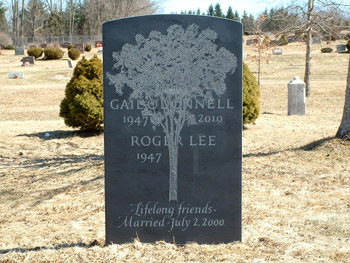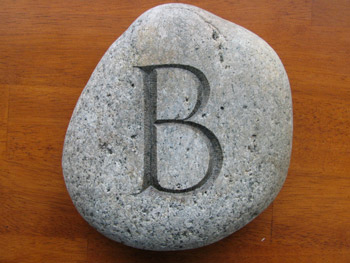Granite Cutters in Maine, Part II
Douglas Coffin, Letter Cutter
by Tom Seymour

Detailed carved slate stone. Slate was used for cemetery headstones from the earliest days of European settlement to the early 1800’s. It was largely replaced by marble and later granite. Softer slate is physically easier to carve, but none of these stones is forgiving of mistakes. Tom Seymour photo
The art of letter cutting, or incising letters in stone, has its roots in England. There, artisans used relatively soft stone such as slate, lime and sandstone as a medium. Although cutting letters in stone is demanding, in that it requires good eyesight and a rock-steady hand, the work was done outside.
The stones, or “bunkers,” were leaned up against a hillside in order to afford the cutter the best angle for working. Also, since candles or oil lamps were the only means of artificial lighting, it was far better to work outside simply because sunlight made it easy to see.
When letter cutters came to live in New England, they found stones similar to what they had worked with in England. Our native slate, in particular, was appealing to letter cutters and two favorite types were Maine black slate and Vermont purple slate. Additionally, Vermont had abundant supplies of fine marble. Thus, the craft continued as before, but now on this side of the Atlantic.
New Medium
However, New England had more than slate and marble to work with. Here was granite, an infinitely harder medium, but attractive and desirable nevertheless. Cutting into granite was so hard on the steel chisels of the day, that a new cutting method came into play. This was called sandblasting and it is employed today in much the same way it was 150 years ago.
Sandblasting came into universal use in the 1860’s. This required much different equipment from what was used to cut letters into slate and other soft stones. For sandblasting granite, the letter cutter would first design the layout on a template, cutting the letters out of a thick, rubber-like material and then affix the template on the face of the stone to be lettered. Then, fine sand, under high pressure, was sprayed on the template.
Interestingly, the sand would bounce off the template material, but at the same time would cut into the stone. Granite carvers of today use this same method. And instead of taking many days to carve a memorial stone, as it would if done with hammer and chisel, the job was accomplished in a matter of minutes.
However, change, though inevitable, does not always mean that newer is better. Sandblasting, by nature, cannot cut as fine or distinct a letter as can be done by hand, with a chisel. Only hand lettering can produce fine, flowing lines and accents such as serifs (the little lines at the base of Calligraphy-style letters).
So even for granite, many jobs demanded hand-lettering. For this, letterers began using carbide-tipped, tool-steel chisels. These were much harder and consequently, went longer without sharpening. Also, since granite comes in nine different hardness grades, letter cutters opted for the middle grades. This grade allowed for letter cutters to perform their flowery, stylized work on a durable but workable medium.
Hand-Lettering Revival
All the same, hand letter-cutting was a dying art and fewer and fewer persons joined the ranks. Were it not for John Howard Benson who learned the trade in 1935, hand letter-cutting as we know it may have simply passed into the mists of antiquity.
Benson, in turn, taught his son, Fud, and it was Fud who hand-cut letters into the Maine slate used for John Fitzgerald Kennedy’s memorial stone. Fud went on to enjoy a long and illustrious career. Fud, in turn, taught his son Nick the trade and Nick went on to greatness. Nick had apprentices, too, and so the effort begun by John Howard Benson was sufficient to keep hand letter-cutting alive and well into the current day.

The hand-carved letter in this granite stone reveals the parallel marks from the steel cutting tool. Today pneumatic power tools can be used. Sandblasting has been a common method of cutting letters and images into stone for more than 150 years. Tom Seymour photo
Today, there are between 20 and 25 hand letterer cutters in the United States. Among these is Douglas Coffin, who works out of his studio in Belfast, Maine. Gone are the days of working outdoors, with a stone propped against a hillside. Instead, Coffin places his stones on a stand inside his shop so that the working area is about shoulder-high. And with the help of electric lights, Coffin is enabled to see every detail on his work.
Douglas Coffin’s hand lettering mostly appears on memorials. However, his hand-cut letters also adorn a prominent building in Boulder Colorado. Douglas got the job of hand-cutting the name of the building on the stone façade. In order to do this, he enlisted the help of a mechanical cherry-picker. Douglas said that this took some time to complete, since eight hours is about the maximum time a person can stand up, cutting letters into stone. After that, shoulder fatigue sets in.
In July, Coffin heads to the Kennedy Center in Washington, D.C., where he will cut the names of donors into the wall. This will be on a piece of Carrara (Italian) marble, the same material Michelangelo used on his masterpiece, “David.” Coffin did work at the center in the past, so this is his second invitation to perform his art there.
Besides cutting letters on buildings and memorials, Douglas also does gold gilding on stone. When left out in the weather, the gilding fades in time, but all the same, lasts for many years. A sample of gilded lettering hangs in Coffin’s office and the bright gold letters on a black background are extremely striking.
Douglas Coffin also does bas-relief on stone. And on one memorial, Coffin has carved a very detailed bird. If he can imagine it, Douglas Coffin can carve it.
Coffin was introduced to hand-cut lettering in Philadelphia, back in 1988. There, Coffin took a six-week course on hand-cutting letters from Richard Grasby, a British letter cutter. The art had remained popular in Britain despite it experiencing a slump in the United States. At the end of the course, Douglas knew he could become a master at hand-cut lettering in stone and saw an application for his talents back in Maine. And consequently, that was just what he did.
Hand-cut lettering was probably a natural offshoot of Douglas Coffin’s previous occupations as graphic designer and calligrapher. And indeed, his eye for letters as an art form is apparent on every sample of his work.
Here’s an interesting thought. The popularity of hand-cut lettering in Colonial days, its decline that began with the advent of sandblasting granite in the 1860s and the eventual revival in the late 1930s, is evident in many of New England’s older cemeteries. To see, in stone, the evolution of the art of hand-cutting letters, just inspect the old slate stone in the oldest section of a cemetery and note the dates.
Then, continue through newer sections, all the while looking for where hand-cut lettering subsides and sand-blasted lettering begins, as evidenced by dates on the stones. And finally, search for hand-cut letters on newer stones. These are very likely from the hand of Douglas Coffin or his daughter, Sigrid Coffin. As so often happens with the traditional arts, the parent passes the trade on to the offspring. And so Douglas Coffin taught his daughter the art of hand-cutting letters in stone. Sigrid works with Douglas in the Belfast shop.
When viewing hand-cut letters on a stone, just think at how the artisan did the work with nothing more than a chisel, hammer and lots of talent.
The phone number for Douglas M. Coffin’s Belfast studio is (207) 338-1466. The address is 19 Cedar Lane, Belfast, Maine, 04915 and his email is douglas.coffin@lettercutter.com. Also, Douglas’s web address is www.lettercutter.com.
